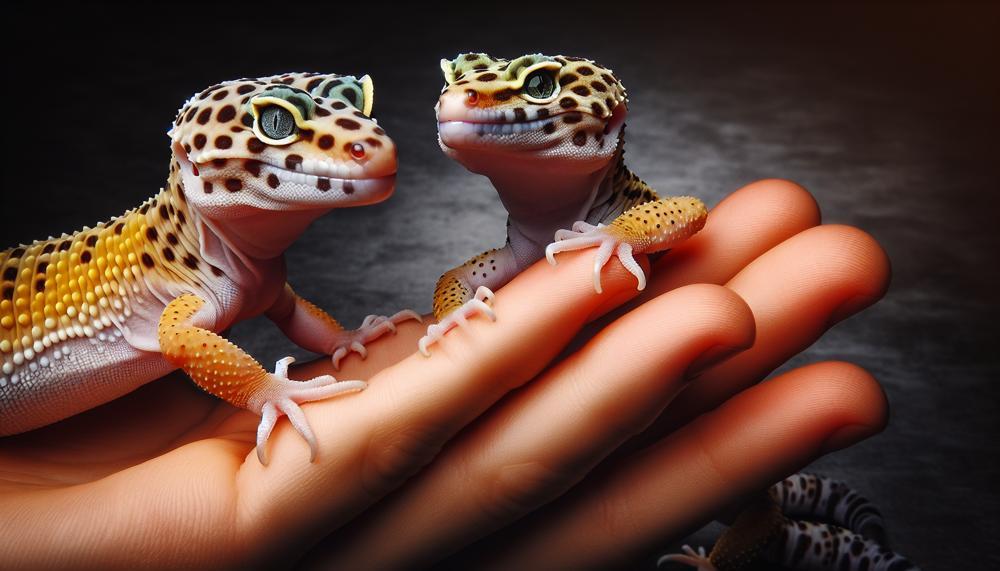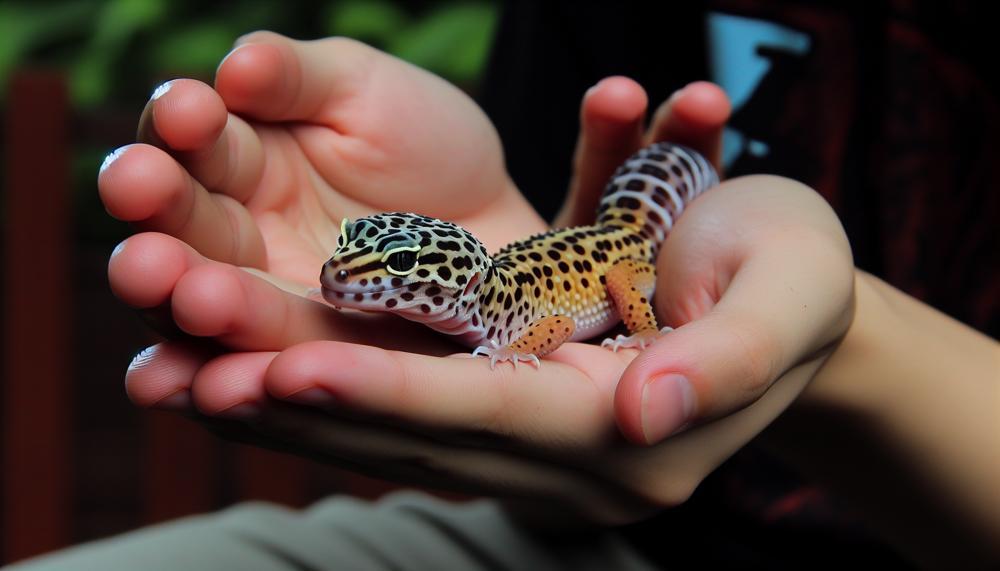Welcome to the fascinating world of leopard geckos, where the line between wild instincts and companionable behavior often blurs in the most delightful ways. These small, nocturnal lizards have captivated the hearts of reptile enthusiasts globally, not only for their striking patterns but also for their unique personalities. However, a question that frequently arises among new and seasoned caretakers alike is whether these scaly friends genuinely enjoy the warmth of a human touch.
In this comprehensive exploration, we’ll delve into the behaviors and body language of leopard geckos to uncover the truth about their preferences for physical interaction.
So, do leopard geckos like to be held?
Leopard geckos are generally tolerant of handling, but they don’t necessarily like it. Some leopard geckos may not want to snuggle with you or be taken everywhere you go. However, if you get your leo used to being handled when it’s young, it probably won’t mind when you hold it.
You can try these tips to get your leopard gecko used to being held:
- Move your hand towards your leopard gecko: Move your hand towards your leopard gecko right where its front legs are and encourage it to step up. For example, press into its legs a little bit and encourage it to step up onto your hand.
- Minimize handling time: Allow your newly homed leopard gecko at least a few days to acclimate to their environment before trying to handle them. Handling time should also be minimized while the lizard is shedding.
- Be careful with frequent handling: Frequent or improper handling can cause them to become stressed, especially if the lizard is young or shedding.
You can tame your leopard gecko to being handled, which can help with vet visits and at-home health assessment.
So, let’s embark on this journey together and discover how to foster a relationship with your pet that is both respectful and rewarding.
Contents
- 1 Do leopard geckos like to be held?
- 2 Understanding leopard gecko behavior in captivity
- 3 Factors Influencing Temperament Variations in Leopard Geckos
- 4 Handling Leopard Geckos: Benefits and Considerations
- 5 Signs of Enjoyment and Discomfort
- 6 Building Trust and Bonding with Your Leopard Gecko
- 7 Factors Influencing Leopard Gecko Preference for Handling
- 8 Avoiding overhandling and respecting rest periods
- 9 Conclusion
Do leopard geckos like to be held?
Leopard geckos have unique preferences when it comes to being held. Unlike sociable pets such as dogs or cats, leopard geckos do not inherently seek physical affection. However, with patience and the right approach, these reptiles may learn to tolerate and even find comfort in the handling process.
Recognizing their comfort level and signs of enjoyment is key for owners who wish to bond with their leopard geckos through handling.
Signs That Your Leopard Gecko Is Comfortable Being Held:
To discern if your leopard gecko is at ease while being held, observe its body language and behaviour closely. Here is a handy table to help you identify positive indicators:
| Behaviour | Meaning | Significance |
| Calm Movements | Leopard gecko moves gently in your hands without frantic wriggling. | Indicates relaxation and trust. |
| Explorative Behaviour | Curiously exploring your hands and surroundings when held. | Shows interest and engagement, not fear. |
| Leaning Into Your Touch | Does not withdraw or jerk away when you gently stroke its back. | A sign of acceptance and possibly enjoyment. |
| Regular Breathing | No heavy, rapid, or irregular breathing patterns. | Stress levels are likely low, and the gecko is at ease. |
| Not Attempting to Escape | Stays within the safety of your hands without trying to leap away. | Contentment with the current situation, indicating trust. |

Building a Trusting Relationship:
To cultivate a bond where your leopard gecko may enjoy handling, consistency is vital. Regular, gentle interaction can foster familiarity. Use treats judiciously to create positive associations with your presence and touch.
Your gecko could start to connect the dots – you with comfort and goodies.
Respecting Their Limits:
Be mindful that leopard geckos are not keen on prolonged cuddles. Limit handling sessions to around 15 minutes to prevent overstressing your scaly mate.
Pay attention to their cues – if they seem agitated, it’s time to return them to their enclosure.
Conclusion:
Although leopard geckos aren’t naturally inclined to seek out human touch, with patience and understanding, they can come to accept and even enjoy being held.
Understanding leopard gecko behavior in captivity
Leopard geckos, with their unique personalities and nocturnal antics, certainly captivate their human companions.
Observing their behavior when held can offer a window into their comfort levels.
Here’s a breakdown of telltale signs:
| Behaviour | Sign of Enjoyment | Sign of Discomfort |
| Calm Movements | A gecko moving calmly or exploring your hand with curiosity likely feels at ease. | Frantic or jerky movements suggest the gecko is stressed and seeking escape. |
| Leaning Into Touch | If your gecko leans into your touch or seems relaxed, it’s a good sign they enjoy the interaction. | A gecko that recoils or tries to move away might be indicating it’s not keen on being held. |
| Regular Breathing | Steady breathing indicates comfort and a relaxed state. | Rapid breathing or panting can be a sign of stress or fear. |
| Escape Attempts | A lack of escape attempts can show that your gecko is content being held. | Trying to scuttle away or climb out of your hands is a clear indicator of discomfort. |
| Chirping Sounds | Occasional soft chirps may be a sign of contentment. | Loud, frequent chirping can be an expression of distress. |
It’s key to note that these behaviours can also be influenced by the gecko’s environment. For instance, a gecko might exhibit signs of discomfort due to unsuitable temperatures rather than an aversion to being held. Thus, ensuring a comfy habitat with proper heat gradients and hideaways is crucial for their overall well-being.
Building a bond with your leopard gecko hinges on regular, gentle handling. Limit these sessions to a quarter of an hour to sidestep undue stress. Your gecko’s individual temperament will play a big role in how they respond to being held, so always respect their boundaries and be patient as you both learn to understand one another.
Factors Influencing Temperament Variations in Leopard Geckos
Temperament in leopard geckos can be as unique as a fingerprint, with each scaly friend showcasing its own array of behaviours. Understanding what makes your gecko tick can be the key to forging a solid companionship.
Genetics
Just like the strands of DNA that weave the tapestry of life, genetics play a pivotal role in the temperament of leopard geckos.
Inheritable traits can pass down a disposition that’s either placid or feisty.
Environment
The surroundings where a leopard gecko spends its days can be a symphony or a cacophony to its senses.
A habitat that mirrors their natural environment with adequate space, hides, and controlled temperatures can lead to a more serene gecko.
Handling and Early Experiences
The touch of a human can be a gentle breeze or a storm to a leopard gecko.
Regular, gentle handling from an early age fosters trust, but rough or infrequent contact may brew skittishness or even aggression.
Health and Well-being
A leopard gecko with vim and vigour is more likely to be affable. Conversely, a gecko facing the gloom of health issues may show a temperament as prickly as a cactus.
How Leopard Geckos Respond to Being Held
The act of holding a leopard gecko can be a dance of understanding. Some may welcome the warmth of a human hand, while others may perceive it as a tango with a predator.
| Personality Type | Typical Response to Handling | Recommended Approach |
| Docile and Friendly | May climb willingly onto your hand and seem at ease. | Regular, calm handling sessions to maintain trust. |
| Skittish and Shy | May try to flee or hide; handling can be stressful. | Gradual acclimation to the presence of hands before attempting to hold. |
| Aggressive and Territorial | Could display defensive postures or nip. | Minimize handling and respect the gecko’s space; use tools like gloves if necessary. |
| Unwell or in Discomfort | May be lethargic or irritable; less tolerant of handling. | Seek veterinary advice; limit handling to reduce stress. |
In the grand tapestry of gecko care, recognizing the individuality of your scaly sidekick is paramount.
With a dash of patience and a sprinkle of understanding, you can turn the pages of your leopard gecko’s story to a chapter filled with mutual respect and affection.
Handling Leopard Geckos: Benefits and Considerations
Yes, handling leopard geckos can be advantageous, fostering a bond and lessening the creature’s stress, if done with care and infrequently.
Key Considerations for Owners
When engaging with your gecko, it’s prudent to be mindful of their comfort and safety. Below are crucial factors to consider:
- Frequency of Handling: Aim to interact with your gecko roughly once per week, interspersing with lengthier sessions biweekly.
- Stress Signals: Abstain from handling if signs of stress are apparent; prioritize your gecko’s well-being.
- Bonding Techniques: Employ gentle sounds, eschew tail grabbing, permit exploration, and use treats to cultivate trust.
- Handling Etiquette: Consider the timing, maintain consistency, and avoid clutching your gecko with a single hand.
Proper Handling Techniques in Detail
| Technique | Reason | Benefit |
| Gentle acclimation | To build trust without overstimulation | Establishes a calm environment |
| Avoiding tail grabbing | Tail is a defense mechanism, may detach | Prevents injury and stress |
| Allowing exploration | Facilitates natural behavior and curiosity | Enriches the handling experience |
Avoiding Stress During Handling
Be mindful of signs like rapid breathing, vocalizing, or trying to escape, as they indicate distress. If observed, it’s kindest to return your gecko to its habitat and try another day.
In essence, treat handling as a special occasion, not a daily routine. With patience and gentleness, you’ll see your scaly pal grow accustomed to your touch, reaping the mutual benefits of your shared time.
Signs of Enjoyment and Discomfort
When a leopard gecko is relishing the warmth and comfort of your hold, you’ll spot several tell-tale behaviours.
They exude a sense of serenity, often indicated by a languid body posture. Their tiny claws may gently tread upon your skin as they explore their immediate vicinity with a harmless curiosity.
A contented gecko might even emit soft chirps or squeaks, an audible sign of their ease.
Signs of Discomfort in Leopard Geckos:
Conversely, a leopard gecko feeling uneasy or distressed in your grip is likely to try and scarper away, a clear sign that they’re not up for cuddles. They might puff up their body, a defensive tactic to appear larger to potential threats.
In more severe cases, they may resort to nipping as a last-ditch plea for release.
| Behaviour | Enjoyment | Discomfort |
| Posture | Relaxed, exploring | Tense, trying to escape |
| Vocalisation | Soft chirps or squeaks | Loud squeaks or no sound |
| Physical Reaction | Still or gently moving | Puffing body, biting |
A leopard gecko’s comfort with being handled isn’t just a matter of their momentary mood; it’s also about the ambient temperature and the regularity of the handling sessions. Too chilly, and they may become sluggish; too warm, and they may overheat. It’s a fine balance to strike.
Remember, each gecko is an individual with unique preferences. You’ll need to learn your pet’s particular quirks and comfort zones over time. Keep the handling sessions brief and infrequent to avoid overstressing your scaly companion. Trust is built over time, and patience is key.
Building Trust and Bonding with Your Leopard Gecko
To foster a bond with your leopard gecko, remember that trust is not instantaneous; it’s a slow dance. Begin by letting your gecko settle into their new digs for a few days without interference.
Once they seem at ease—showing curiosity rather than skittishness—you can start the trust-building process.
Establishing Routine and Familiarity
Geckos are creatures of habit, and they’ll come to recognise the routine you establish.
Consistent interaction, like speaking softly when near their enclosure or offering food at the same time each day, creates a sense of security. They’ll start associating your presence with these non-threatening and even enjoyable activities.
Gradual Handling
Once your gecko is accustomed to your presence, you can begin to introduce handling sessions.
Start with short intervals, and as your gecko becomes more comfortable, you can gradually extend the time. Always approach from the side rather than from above to avoid triggering a predatory response.
Table of Handling Tips
| Do | Don’t | Reason |
| Approach from the side | Approach from above | Approaching from above mimics a predator’s attack. |
| Handle during dusk or dawn | Disturb during daylight rest | Geckos are most active at twilight hours. |
| Start with brief sessions | Rush the process | Builds trust without overwhelming them. |
| Be consistent with sounds | Make loud noises | Familiar sounds can be soothing. |
| Hand-feed occasionally | Force interaction | Associates your hand with positive experiences. |
Sensitivity to Your Gecko’s Mood
Pay heed to your gecko’s body language. If they’re showing signs of distress, such as trying to escape or tension, it’s time to give them a break. Learning to read these signals is paramount in building a trusting relationship.
Patience is Paramount
Some days, your gecko might not be in the mood for socialising, and that’s alright. Never take it personally. Patience is your best ally in this journey of companionship.
By dedicating time and demonstrating consistent, gentle behaviour, you’ll find your leopard gecko warming up to the idea of being held. Remember, each gecko is unique, and they’ll warm up to you on their own terms.
Factors Influencing Leopard Gecko Preference for Handling
Leopard geckos, native to arid lands, have unique preferences when it comes to human interaction. Their solitary nature and survival instincts shape their comfort levels with handling.
Here’s a deeper look at the elements that sway a leopard gecko’s fondness for being held:
| Factor | Influence on Handling Preference | Notes |
| Trust and Bonding | Essential for positive handling | Develops with consistent, gentle interaction |
| Age and Experience | Younger/more experienced geckos may be more receptive | Past positive interactions can increase handling preference |
| Health and Stress | Healthy geckos are typically more tolerant of handling | Watch for signs of stress, like body language changes |
| Individual Personality | Varies from gecko to gecko | Some may naturally enjoy handling more than others |
| Environment and Alternatives | Feeling safe and having play options can enhance handling | A secure habitat and mental stimulation are key |
Remember, every leopard gecko is unique and understanding its personal preferences takes time.
Avoiding overhandling and respecting rest periods
Leopard geckos are indeed fascinating companions, with their velvet-like skin and gemstone eyes. They require a gentle touch and ample space to thrive.
To respect their need for rest and prevent stress, a careful handling schedule is essential.
For Juvenile Geckos:
- Frequency: Once every few days
- Duration: 5-10 minutes
For Adult Geckos:
- Frequency: 2-3 times a week
- Duration: Up to 15 minutes
Table of Recommended Handling Sessions:
| Age Group | Frequency | Duration |
| Juveniles | Once every few days | 5-10 minutes |
| Adults | 2-3 times a week | Up to 15 minutes |
The Golden Rules of Gecko Handling:
- Observe your gecko’s temperament; some may prefer shorter sessions.
- Avoid handling during shedding or just after feeding.
- Always handle in the evening or early morning, aligning with their natural cycle.
- Support their body fully, being mindful of their delicate frame.
- Wash your hands before and after to keep both you and your gecko safe.
Remember, each gecko is an individual with its own quirks and comforts.
Conclusion
In conclusion, while leopard geckos do not naturally like human contact as some other pets do, they might eventually come to respect and even enjoy it. A gecko’s relationship with its owner is a delicate dance that calls for tolerance, compassion, and an acute awareness of the creature’s comfort cues and body language.
Leopard geckos and their owners may develop a deep bond by gentle and frequent handling, providing a secure and comfortable habitat, and respecting each animal’s unique personality and restrictions.
Leopard geckos all have a desire for protection and comfort, even if their temperaments differ according to factors including heredity, environment, early experiences, and general health. Minimize stress and provide a good handling experience for your gecko by taking the time to identify and react to its behavior. Recall that consistency and consideration for the gecko’s limits are crucial.
In the end, touching leopard geckos may help them socialize and increase your pleasure of these amazing animals, even if it’s not required. Every gecko is different, as we’ve seen, and their desire to be handled will fluctuate.






